As a librarian with a futuristic bent, Heath Rezabek has developed the Vessel Project as a way of studying how we can preserve our knowledge and culture against future risk. That work — and Heath’s ongoing engagement with the Long Now Foundation — asks what we might put into a long-term archive housing the essence of our community. Finding the answers involves ‘community curation,’ asking varying interest groups to develop and discuss their choices. We’re going to run such a survey with the Centauri Dreams readership, helping to firm up a shortlist of books on interstellar topics that I’ve been wanting to return to for some time. That list will appear tomorrow, but today Heath explains strategies for building archives to represent communities like the one that clusters here around interstellar flight.
by Heath Rezabek
In my first Centauri Dreams installment, I noted that I had recently begun an Internship with the Long Now foundation, assisting and advising in their initial community curation of a 3,500 volume collection called the Manual for Civilization. At that time, I promised updates on the project as it progressed, since it bears such a kinship to themes and objectives reflected in the Vessel Project. I have not yet done an update.
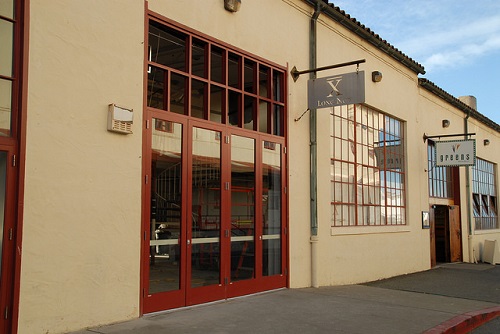
Image: The Interval: Long Now Foundation, San Francisco, CA.
With the site of the collection soon to open — the name of their headquarters space being The Interval — and with myself about to make a trip out to San Francisco for part of those opening activities at the end of May, now seemed like a good time to reflect upon my experience as an Intern on the Manual for Civilization. The Internship draws to a close, and I look towards the future, by considering the importance of community curation at all levels and in all kinds of communities. I will also tie these thoughts back to current and prior work on the Vessel proposal, and launch an effort towards community curation of a core reading list for Centauri Dreams readers based on Paul Gilster’s existing shortlist on interstellar research.
As a brief summary, the Long Now Foundation is a nonprofit organization whose purpose is to foster long term thinking through concrete projects which catalyze public debate and discussion about the very long term, while at the same time striving for substantial real-world goals. Its cornerstone project is the construction of a 10,000 Year Clock, “designed to run for ten millennia with minimal maintenance and interruption. The Clock is powered by mechanical energy harvested from sunlight as well as the people that visit it. The primary materials used in the Clock are marine grade 316 stainless steel, titanium and dry running ceramic ball bearings.” No completion date is set, but construction work at the first site in west Texas is in preparation.
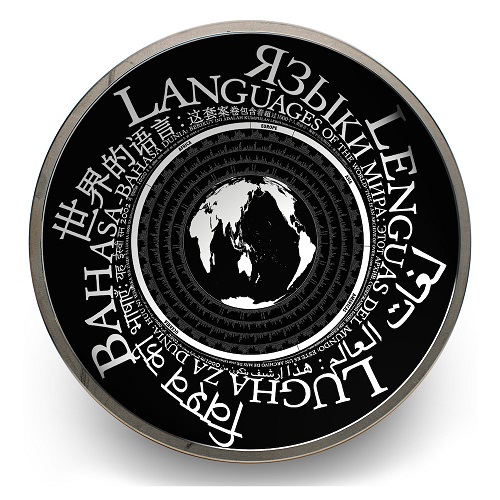
Image: The Rosetta Disk.
Another project with concrete utility as a key for decoding 1,500 human languages is the Rosetta Disk. At the ESA’s invitation, an early copy of this disk is on the Rosetta probe.

Image: The Rosetta Probe (ESA).
Over time, Long Now has undertaken numerous other concrete efforts, and the Manual for Civilization is one. This collection is to be a 3,500 volume book collection and library, housed at its new headquarters in San Francisco, The Interval. At time of launch, their plan is to have 1,000 of those volumes on the shelf, and to build the rest of the collection over time through various community-driven means. These include annual vetting of the existing collection and the chance to debate the addition or removal of items in what is proposed to be a fixed number of items.
The overarching question used to drive curation is “What books would you most want to help rebuild civilization?” To ask this question of a small subset of individuals is, obviously, to push them to think well beyond their means (much as is true of asking designers and engineers today to plan towards building an eventual interstellar starship). Yet this is a community dedicated specifically to long-term thinking, and to fostering that activity through its efforts.
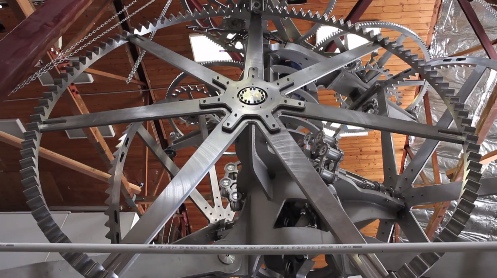
Image: The 10,000 Year Clock Prototype (Power and Winder test).
One of the earliest critiques and responses to the Vessel proposal on Centauri Dreams was from a reader who could not see the point of attempting comprehensive archival of cultural content in the first place (much less other material, such as endangered biomass or scientific knowledge). The reader suggested that individuals and communities would always be undertaking archival tasks and the passing-down of their own heritage, making any kind of concerted effort unnecessary.
As a librarian, I continue to disagree; yet working on the Manual for Civilization project has reminded me that there is a spectrum of appropriate response to the need for remembrance as a mitigation of permanent stagnation or flawed realization. While the first draft of the Manual for Civilization does strive to be comprehensive, there is also significant room for interpretation and opinion in its scope. Its primary categories, at this stage, are a blend of comprehensive and community-focused topics: Cultural Canon and Mechanics of Civilization are both categories which point at widespread and general utility (once fleshed out by the addition of unfamiliar or more broadly global materials). The two other initial categories, Rigorous Science-Fiction and Long Term Thinking/Futurism, are there in part because of their direct interest to the specific community doing the curation — in this case, the Long Now Foundation.
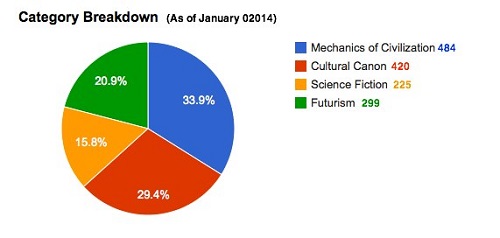
Image: Categories in the Manual for Civilization (as of January 2014)]
With the facility and its opening events now in sight, Long Now has been bringing together existing physical copies of many works on the shortlist, as well as seeking out donor copies to fill out the collection. I myself have committed several to those shelves, including two signed editions. I have been impressed by the positive response seen both in the public, as well as in myself, to the prospect of helping to build a physical reference collection meant to endure over time.
It has also convinced me that similar processes could be carried out for other communities of interest, and perhaps with different types of materials. Empowering a community to build what amounts to an extended wishlist for that collection becomes the first step in establishing and stewarding its cohesion over the long term.
One of my own contributions to the process was the proposal that we create a customized build of the allourideas.org A/B sorting platform, (which I find useful for a great many things). This was done, allowing the project to pull ISBNs and other metadata into the survey from a custom metadata entry system. The community was invited to propose titles, and begin the process of sorting the ones already in the list.
Additionally, and appropriately, the core collection was seeded with the personal shortlists of Long Now’s founding members and some community exemplars (as I call them). (See Brian Eno; Neal Stephenson; Stewart Brand; Kevin Kelly. A blending of the lists — the community curated A/B lists and the shortlists of community exemplars — was undertaken by Long Now leadership, and thus the first curation list was born.
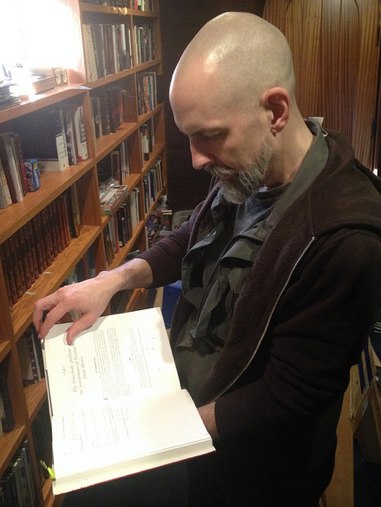
Image: Neal Stephenson selects titles for his shortlist, as a community exemplar.
During this process, we encountered a few questions regarding the diversity of the collection and its sources. The most public and illuminating of these questions came from Maria Popova, who runs an outstanding literary blog called Brainpickings. Her list and discussion was illuminating in itself, but it also helped me over a mental hurdle in understanding the purpose and point of such a process, and this has enriched my own conception of the larger long term goals of the Vessel Project.
As I wrote in my comments-response to a similar inquiry on the Long Now blog,
“I do think it’s important to remember that this particular collection is meant, initially, to serve as a core collection reflective of its hosting organization, housed at their headquarters site. While the question of what would most help rebuild or preserve a cultural core is a crucial one to ask, there might also be as many answers as there are communities of interest willing to ask it. I think that’s a good thing, actually: it reminds us that no such collection could ever be absolutely authoritative unless it were nearly exhaustive, but at its best might strive to be a reflection of its constituents’ ideals and aspirations. The wider that circle, the more comprehensive the collection — but universal representation right from the start would be nearly impossible.
The core lists being submitted by founders and community [exemplars] is only one current going in to the process. […] Every such collection is bound to differ in its details, and in those differences lie a strength. Who’s to say which resources will confer the greatest resilience or remembrance for a given community, other than that dynamic community itself? We can aspire, but more importantly, I think, is that the question “What do we feel is most worth passing on over the long term?” be asked, by as many unique communities as can.”
In articulating this, I had arrived unexpectedly at a middle-ground between the original ideal of Vessel — the seeding of numerous institution-level comprehensive collections, secured against unforeseen catastrophes in a range of ways — and the default remembrance strategy of throwing seeds to the wind, come-what-may, suggested by the critique that everyone will already save whatever matters for themselves.
The community of interest is the place where those two strategies meet.
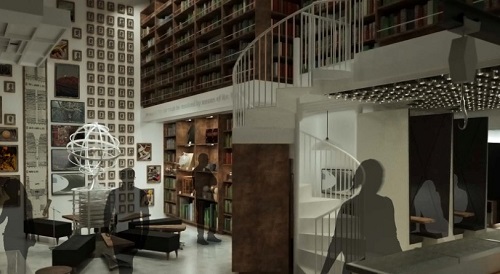
Image: Interior visualization of The Interval.
This middle ground suggests a larger role for what I call community curation and community collections. Community may be very broadly defined, to include everything from a small family to a whole nation or colony. It seems useful to consider the possibility that larger collections might be built up of smaller collections: if each item and set of items bequeathed to a community collection is vetted for its long-term importance (however one wishes to define that), then as a whole the collection will reflect this objective even if the sets within it differ significantly.
The key element is to ensure the asking of the question. It can be phrased in different ways, complete with the differences those many ways suggest. “What would you place in a vessel containing the essence of your community?” “What is important enough to you to pass on beyond your own time?” “What best reflects the essence of your community’s knowledge and influences?” “What is most worth saving?” “What is at most risk of being lost?” And so on.
There will always be space and a place for those who answer this question simply with their lives, by saving what they value in their own collections and passing it on when they themselves pass on. However, given the complex challenges which face future generations (wherever they may make their homes), the asking of these questions and the community curation of collections which result may serve as crucial guidance in the short and medium term. Perhaps surprisingly, and perhaps controversially, we can propose that the greater the number of these communities and diversity of their resulting collections, the greater these collections’ value to communities in the future.
In other words, the idiosyncrasies seen in the Long Now Foundation’s collections, far from being a weakness, are a source of hybrid vigor and a carrier wave for the priorities this particular community will have as it evolves. A community has asked a particular question, and preserved its own unique approach to adapting as it moves into the future.
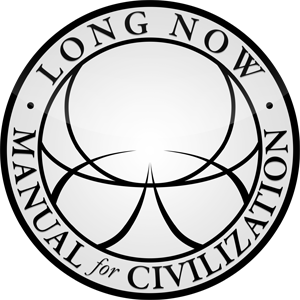
Image: Manual for Civilization (Logo).
At the end of May, I will travel to San Francisco to celebrate this Internship and to see the collection in its seedling stage. I will return with a renewed sense of direction and purpose for the Vessel Project, clear to me already in outline. Future efforts will continue to ask the question of curation to, hopefully, a range of communities. Each will answer somewhat differently, and in these differences will lie those communities’ particular traditions.
The results of these Vessel Surveys will be made openly available whenever possible; books are perhaps an increasingly controversial medium to use as a baseline, but they are also surprisingly resilient as media, and in the short term are good markers for particular ideas, priorities, and influences. Vessel Surveys which embrace other media are possible as well.
Not all will focus immediately on core materials for rebuilding civilization, but might initially focus simply on the themes and ideas integral to that community. Such would be the case with a thematic community like Centauri Dreams.
In this spirit, and with Paul’s blessing, I would like to facilitate a community curation of the Centauri Dreams readership. Initially, we will start with books; but if comments suggest that ideas or some other carrier for influence is preferable, we can launch a survey for that type. This is an experiment and a gift, from one member of the Centauri Dreams to all others, and from all of us to all who come.

Image: Centauri Dreams: Community Curation Vessel Survey (Live tomorrow).
In the fullness of time, who knows who might find these influences pivotal to their own exploration?
Tomorrow, we’ll present Paul’s initial shortlist of key books as influences, and then we will open up a Vessel Survey for suggestions of others from the community.



The Rosetta Disk. At the ESA’s invitation, an early copy of this disk is on the Rosetta probe.
I hope ideas will be included in this project beyond picture writing and math codes for human attempts to communicate with spacefaring alien civilizations encountered…By AD 10,000 some human languages might have become alien to the vessel librarian…expect the unexpected…
I trust that the collection will extend beyond just books. Even in our narrow Centauri Dreams community, I would want to see other media and even possibly artifacts included. If Sagan’s “Murmurs of Earth” were to be selected, I would hope that the multimedia disc would be included. Or perhaps there would be a movie that shows our aspirations, or perhaps a documentary.
The first question that comes to mind is why you would store the ‘Manual for Civilization’ in San Francisco? The likely need for this manual would probably occur after a devastating war or similar disaster has destroyed the major cities.
Also some of the categories (science fiction) don’t seem helpful for survivors trying to reboot their small communities. Do-it-yourself books on construction, engineering, food preparation, sanitation, and field medicine – would probably come in quite handy. Numerous copies of these books should be cached at relatively safe sites.
Yes; this particular community curation is for Centauri Dreams readership, as an experiment. The longevity and scope issues are ones Long Now is well aware of and will continue to work with over time.
The idea of artifacts being included in our own community collection is very interesting! Even if just as a wishlist, the inclusion of (a replica of) the Voyager disc would seem quite appropriate.
Maybe tomorrow, when the survey goes live, I’ll add it! Or you can, Alex.
One thing I would very much like to see is the development of a storm cache – secure locations that contain not just the knowledge (on vacuum sealed books and Rosetta HD, readable with microscopes), but also the tools to rapidly rebuild civilisation after a catastrophe.
Included would have to be some sort of new language, or at least educational materials on gramophone to teach literacy… it would otherwise be useless to illiterate folk breaking in generations after. Though with the knowledge of where they are in fairly common knowledge, it shouldn’t take that long. Included also would be a fairly comprehensive seed bank, as much as can be provided in the small space designated, and the DNA of as many organisms as possible in storage.
As a much larger project, which could be started now but will become especially useful as part of an interplanetary/interstellar internet, I want to see Alexandrian Archives, containing all the worlds knowledge and works. Well, probably not every video on YouTube, all the worlds porn, peoples Facebook statuses, and perhaps not even all the Fanfiction people have written (although, a lot of them deserve it more than the original works).
One nontrivial issue is to find a robust way to ensure the persistence of the encoding and decoding formats. We don’t want to find ourselves in the position that, after some kind of societal “reset” event, we’re unable to access and comprehend our own archive.
Probably unfortunately (and not meant to rain on anyone’s parade), but the Long Now Foundation and its Manual for Civilization reminds me of H.G. Well’s War of the Worlds. In particular the chapters having to do with the narrator’s interactions with the artilleryman. If you have read it, and I suspect that you have, you recall that the artilleryman had great and noble dreams of humans living under the “feet” of the invading Martians. His was a complete vision of what would be conducted within the sewers of London to maintain civilization after the fall of mankind. Yet, the narrator finally realized that these dreams were impractical ultimately, as the artilleryman attempted to dig a tunnel to the sewer from a house he was living in at the time. Why, the narrator wondered, didn’t he just walk over to the sewer and climb down a manhole? Why begin a project of such magnitude in a house that could very easily be blown away by a passing Martian.
Or to put it more succinctly, why put a library to rebuild a civilization in San Francisco on a major earthquake epicenter? It seems to me that such a library might be instanced in such a location, but the actual library itself should be etched into long lived mineral crystals and stored with the 10,000 year clock or something. Yes, I suspect that the idea is to build a library that could ultimately be placed aboard a multi-generational starship, but still…if the idea is to build an artifact of significant duration, then why begin by putting its only instance in a location of substantial risk?
For that matter why headquarter the Long Now Foundation in San Francisco..for the same reasons? Isn’t it kind of contrary to the vision in the first place?
I think it’s excellent that folks are commenting on the Long Now effort in particular even though our own aims tomorrow are more focused on interstellar research.
Note that the SF collection is for their HQ space, which is meant to be a companion to their event space and social space, and is not positioned as a mission critical vault of an archive in itself. Think of that particular physical collection as a conversation starter.
That said, all it’s items will be mirrored at the Internet Archive, which does have at least one mirror that I know of (Alexandria), and should ultimately have more.
Actual resilient physical archives for mission critical recovery would need all these factors considered; that is the bread and butter of the Vessel project (which is quite separate from Long Now’s own effort).
For Long Now one option would always be co-location with their Clock,the first of which is being built in a geologically stable region of west Texas.
For projects similar in spirit, of course, options abound. All to be explored as opportunities present themselves.
Making durable copies is cheap. I think it is appropriate to house the institution at a central place with many people. Without a community, there can be no community effort. San Francisco will do, New York would be better.
Today, all of Wikipedia can be stored on a thumbdrive. Why chose just 3500 books? The whole thing seems like merely an enlarged version of the hopelessly pointless “If you could bring one book to an island” fantasy.
And old-fashioned bound books? Those could be pretty decomposed after 10,000 years, and do not resist fire and water very well. Engravings on glass or crystal seems a much better option, as others have said.
I find the idea that a large number of varying community collections of books (and other media) will be most useful in the future fascinating. It would be very hard to make one single collection that reflects all the varying communities that comprise civilization, so perhaps the best way to preserve important knowledge is to let those communities choose what to collect themselves… and to encourage the formation of as many communities as possible!
This strategy is perhaps much stronger than a sealed, remote Archive of Civilization. Community collections encourage people to be engaged with the knowledge they are curating, and encourages it to be shared among and freely accessible to everyone.
Perhaps this will do the most to influence our society away from the twin hazards of stagnation and flawed realization. Of what use would a sealed archive be if the people it was meant for forgot to gather and share knowledge amongst themselves?
I have for a while wished to create a bibliography of the books and papers on interstellar travel that have been useful to me just for my own use. Just think how useful a community book list would be for people interested in starflight. I am rather excited and hopeful about the Centauri Dreams community curation project!
I will perhaps suggest some titles that were important for me if they don’t come up in the lists to ensue… and I am looking forward to that shortlist of yours, Paul!
Books?? C’mon, we are in the computer age! Digitize the books, put them in a torrent file and distribute it by Internet. It will be far more secure than storing them in a single building in paper form.
It’s a stunning concept. Unlike the clock, which is cool in representation but poor in utility, this creature would actually be useful. As one member of the human conglomeration I am so happy that someone is thinking about these issues and doing it so forthrightly. I do have a few questions:
Perhaps I am missing the primary thrust of the library in offering this criticism: what is ‘cultural canon’? One hope this would include literature and art, being in fact our highest aspirations.
How did so many significant figures arise in the division of topics (i.e., 33.9%) ?
And finally- again, if I miss the thrust the following will be impertinent- doesn’t the inclusion of SF trivialize the effort? We loves our SF here on Paul’s site, to be sure, but it won’t show a city slicker how to grow tomatoes.
I am guessing the Long Now library and foundation are in San Francisco because it is easier to reach than some remote mountain region such as where the Clock is going to be. Plus SF is an excellent resource for progressive people and ideas, which I am guessing a sparsely populated place in the middle of nowhere would not be.
That being said, once things are established, I would hope the Library would be duplicated all over Earth, in places both remote and easy to reach. This would include space.
I would like to think that the very existence of the Library and Foundation would get people thinking more about our real future not just the next business quarter for example, and take steps to preserve our knowledge and species, and civilization.
Here is my take on preserving ourselves for future generations, both of and off this world:
https://centauri-dreams.org/?p=26171
Heath Rezabek, along with the Voyager Record I hope you will also consider the Pioneer Plaque to include with the Library artifacts:
https://centauri-dreams.org/?p=22712
Along with a copy of Walter M. Miller’s great cautionary novel A Canticle for Leibowitz:
https://archive.org/details/ACanticleForLiebowitz
@Eniac – 3,500 books is a symbolic starting point, because the tangible goal is an attractive and provocative collection for their public venue. No actual 10,000 Year Library would consist of just-books, much less only 3,500 of them. That’s just the shelf space they have at The Interval. http://blog.longnow.org/02014/05/09/first-look-at-the-interval-at-long-now/ I do think the question of what the essence of a community’s influences are (the ‘deserted island’ question) yields important results, though.
Paper doesn’t last forever, but at the moment, there’s a lot of stuff in print which won’t be in the future, encapsulated in a relatively stable and organizable form (books). A shelf of books remains a fine way to reflect the character of a community of interest over the medium term. Crystal and other resilient media are the kinds of things I’m interested in for the Vessel proposal, and over the long run I imagine Long Now would utilize such media as well for any eventual 10,000 Year Library.
@Christopher – Agreed – To me the important thing is that numerous communities ask this question, and begin seriously compiling local caches for themselves. My hope in the future is to help other communities to do just this.
@Antonio – Bits are surprisingly ephemeral, far more so than paper, in cases of EMPs or cases where redundant media are not used. My own feeling is that mission critical material should be cast into as many alternate and resilient media formats as possible, in each instance.
@ Michael – Cultural canon would include art — or at least books about art. In this case, it’s just a shelf topic; as you guess, any comprehensive collection would need exemplars of great works of all kinds — art, music, etc. The precise percentages come from the fact that we pulled in a pretty large number of titles, and the more titles, the more precisely the percentages would break down.
Criticism of SF’s importance did arise, as did criticism of titles on fart-future thinking / future studies. But, to me, these sections specifically reflect the character and interests of this particular community — Long Now — and its constituents, and like a fingerprint, such focused information is of value. Moreso the more communities try to answer the question of core curation. Centauri Dreams has a lot of books about interstellar prospects, because that’s its focus. But it’s also a very specific topic, like SF and Futurism is for Long Now. Personally, I feel that SF has a lot to offer at a right angle to any cultural canon. 1984 might or might not end up in a canon; same with the works of Verne or Wells or PKD. But they all say something important about the ways we have approached the future over time.
@ljk – The library and foundation HQ are in SF because that’s just where they are, as well as some reasons you mention. I have no doubt that ultimately, any 10,000 Year Library would be in as stable a location as they can find, perhaps collocated with the clocks.
Widespread repositories of this sort is not their main objective; they undertake ambitious, concrete projects to spark debate and thought. The Vessel project does aspire to widespread instances. Zander Rose and I spoke at some length about Long Now’s approach in spending their energy on projects that in turn inspire others, rather than trying to do everything. So yes; you kind of guessed this.
Criticism of SF’s importance did arise, as did criticism of titles on far-future thinking / future studies.
(far-future); misspelled.
Antonio actually has a very good point. Perhaps the effort would be better expended in building internet archive facilities. Just push all of the material onto the internet, at the same time making sure that the internet is well backed up in vast long term archives.
This reduces the problem considerably: Instead of telling potential users how to build a civilization, you just need to teach them how to read the archives. If those are all digital, that is not trivial, but it is still much easier than teaching all of a civilization.
Some very durable artifacts aiding in the playback of digital information could be a useful shortcut. Could we design an electronic tablet that lasts for a million years if properly stored? All solid state, with solar cells? Perhaps a more interesting challenge than a large clock.
While plans are made to rebuild civilization and survival skills will be paramount, please do not forget that eventually civilization will return, which means that people can and will want to do more than just survive.
Preserving the arts and humanities will be just as important for their psychological enrichment and sanity as knowing how to remaster electricity and plumbing. Not to mention that great literature and music are important means in their own right.
Humans can survive on bread and water, but not terribly well and without something more they often do not want to bother at all. Or worse, they accept this as the best they can hope for in life and the result is something worse than extinction. Do not forget the arts and humanities unless you want a society of flesh-covered robots.
As for electronic preservation of knowledge, my concerns lie chiefly with how will people be able to read them in the far future – or even not so far future. I am not even talking so much whether they will have the educational capacity to do so as whether they will have the equipment necessary to achieve the task. There is something to be said for carving words and diagrams into stone or clay tablets that will then harden.
I already have boxes of old floppy disks which I can no longer look at, not at least without making some effort to do so. And my old VHS tapes seem to be headed for a similar route.
Perhaps the Time Capsule made for the 1939 World’s Fair can be a guide here:
http://davidszondy.com/future/timecapsule/timecapsule1939.htm
The makers included publishing a book titled The Book of Record and placed it in libraries all over the globe so that at least some future generations might remain aware of its existence and remember to open it in the year 6939. It is also online at the link above.
Despite its bizarre history, the Georgia Guidestones do have certain merits in terms of preserving knowledge in the wake of disasters:
http://archive.wired.com/science/discoveries/magazine/17-05/ff_guidestones?currentPage=all
@Eniac – the issue of archiving knowledge has been extensively looked at. It doesn’t have to be either/or. For readability at most levels of civilization, books made of vellum (or other long lasting medium) pages, printed with ink, are proven to last centuries, even with poor handling. Stored in special chambers, as the Vatican does, is even better.
Replication is obviously advantageous, but the ease of digital copying belies the problem of not having a suitable infrastructure to read the contents. File formats keep changing, and current storage media has unproven lifetimes. IMO, a risky proposition if civilization is really kicked back to even early C20th levels. I would stick with some sort of books in addition to digital media. Some of the new solid state systems look promising if they prove truly robust.
One other problem is going to be language drift over time. Words change spelling and meaning over time. This can be partially compensated for with a Rosetta Stone type dictionary, which the Long Now Foundation has thoughtfully done.
Alex: I agree that there should be documents readable without instruments. What I was trying to say is that these need to be provided only for the single purpose of teaching how to access the real treasure, the complete digital Internet archives. I understand that this is not trivial, but it has to be easier than printing it all out, in whatever physical form. The absence of search alone is going to make a printed archive unusable, practically.
The question remains: Which is easier, putting together instructions for how to build a reading device from scratch (including a fairly powerful computer to process the data), or providing ultra-long lived electronic artifacts to provide acess immediately and tide users over until they manage to make such things, again, perhaps after many generations.
Language drift should not be a problem. We are doing pretty well today in understanding the written languages of the past, even those that have long since vanished from human discourse.
The biggest danger to humanity – our own stupidity:
http://io9.com/what-most-freaks-out-scholars-who-study-the-future-of-h-1575379902
A collection of online articles and books about communicating and preserving items across really long periods of time:
http://www.physics.uci.edu/~silverma/benford.html
http://www.kellianderson.com/MSthesis.pdf
http://www.wipp.energy.gov/picsprog/documents/Ten%20Thousand%20years%20of%20Solitude.pdf
http://www.wipp.energy.gov/PICsProg/articles/Village%20voice%20article.pdf
http://openhumanitiespress.org/architecture-in-the-anthropocene.html
@Eniac – I agree that digital archives would be nice, as they’re so potentially voluminous. Having a bread crumb trail leading one to the ability to reinvent or restore such devices would be good in addition to the kind of solid state device you mention. No method is redundant to the point of pointlessness (is that a point?), as we simply cannot foresee what media and means will confer an advantage. I say, try ’em all.
These days I’m pretty taken by the idea of at least one substrate being digital data cast in DNA. The volumetric properties alone are mind-blowing, and if we preserve a bread crumb trail to an understanding of genetics, then the data stored is gravy: Genetic material stored to preserve and recover biodiversity would be priceless.
As far as current-day distributed archival goes, I’m pretty excited about the grassroots potential for a little technology called BitTorrent Sync (which uses the BitTorrent protocols but is as simple as identifying a folder you want mirrored back and forth to backups anywhere and everywhere someone receives the key.) A DIY version of LOCKSS – Lots Of Copies Keeps Stuff Safe. bittorrent.com/sync
@ljk – That’s a great little cache of long term storage links. Thanks for them!
Storing data onto DNA. Talk about redundancy….
http://www.engadget.com/2014/05/14/artist-stuffs-wikipedia-into-apple-dna/
In ten thousand years the radiation levels would be around the same as for the ore that produced the fission material in the first place. The caesium and strontium which are the really dangerous ones will be vanishingly small in only hundreds of years.
@Heath Rezabek
‘These days I’m pretty taken by the idea of at least one substrate being digital data cast in DNA. The volumetric properties alone are mind-blowing, and if we preserve a bread crumb trail to an understanding of genetics..’
It could be better to encode the information in a chain of hydrocarbons, a carbon back bone with hydrogen/deuterium or Bromine atom side chains representing ‘bits’ would produce staggering volumes of information storage. Each carbon bond atom and bond distance is in the low sub nano-meter range per bit and in a nice flexible chain. The storage would be magnitudes higher than DNA or anything we have now.
Reading it would be slow but if it is for long term storage that would be fine, oxidation could be an issue though but water may do fine as a storage medium. An issue with DNA replications is that every now and then (~1 in 4 billion) there is a mistake in the copy encoding, but could be removed or lowered with techniques such as Reed–Solomon coding.
Heath: Agreed. Only, I do not see as much potential in DNA for digital storage. DNA is fragile and unreliable. If it is dead, it decays easily. If it is alive, it mutates uncontrollably.
In theory, defects introduced with atomic precision in 3-dimensional crystals (diamond, in particular) have DNA beat by many orders of magnitude, in terms of storage density and durability, both. We do not have a way to write or read such data, yet, but that is only a matter of time, I think. Maybe we’ll find an archive that will teach us… ;-)
Or, we’ll just have to figure it out ourselves.
Messages and videos will be radioed onto the New Horizons space probe after its flyby mission to Pluto in 2015.
Some pertinent new articles, with some very revealing comments relevant to the thrust of the main CD article:
http://www.smithsonianmag.com/science-nature/golden-record-180951490/?no-ist
http://news.nationalgeographic.com/news/2014/05/140517-global-selfie-message-new-horizons-space/
To quote from the above article:
“According to Stern, the spacecraft could outlive Earth. “The spacecraft will be in the middle of nowhere,” he says. “Nothing can happen to it.” However, cosmic radiation may eventually corrupt the spacecraft’s electronic memory. The New Horizons message won’t last nearly as long as the metal missives attached to Pioneer and Voyager will.”
So HOW long will these messages last exactly? Rather key to whether anyone will ever find them or not. This is yet another reason why I have always felt they should have put something physical which contained useful and understandable information about our species and our world before launch.
The new New Horizons Message site, where you can give your one-word description of Earth and humanity:
http://oneearthmessage.org/
And although you did not ask, here are my numerous thoughts on preserving humanity through information stored aboard space vehicles:
https://centauri-dreams.org/?p=26171
How about saving science fiction films, especially ones involving our natural satellite?
Here is a comprehensive list of such cinema, from the classic to the oh vey!
http://www.thespacereview.com/article/2518/1
An arthouse on the Moon:
http://www.crowdfundinsider.com/2014/05/40480-moonhouse-prepares-crowdfunding-campaign-house-moon-project/
http://www.space.com/26030-moonhouse-art-project-moon-images.html
http://www.cfa.harvard.edu/news/2014-23
Volunteers Needed to Preserve Astronomical History and Promote Discovery
Release No.: 2014-23
For Release: Thursday, September 4, 2014 – 10:00 am
Cambridge, MA –
Before iPhones and laptops there were human computers, some of whom worked at the Harvard College Observatory. Women like Henrietta Swan Leavitt, Williamina Fleming, and Annie Jump Cannon made some of the most important discoveries in astronomy in the early 20th century. Their work was even featured in the TV series Cosmos, hosted by Neil deGrasse Tyson. Now, Harvard is seeking your help to transcribe the logbooks that record the century-long observations behind (and beyond) their discoveries.
“Digitizing the ~500,000 glass plate images covering the full sky will foster new scientific discoveries for the currently ‘hot’ field of studying variability of astronomical objects, or Time Domain Astronomy, as we bring to light these long-hidden archives,” says Harvard professor Josh Grindlay, the leader of the Digital Access to a Sky Century at Harvard (DASCH) project.
The telescope logbooks record vital information associated with a 100-year-long effort to record images of the sky. By transcribing logbook text to put those historical observations in context, volunteers can help to unlock hidden discoveries.
To participate in this new “citizen scientist” initiative, interested parties are invited to sign up at https://transcription.si.edu/browse?filter=owner:11
We need to transcribe more than 100 logbooks containing about 10,000 pages of text. We seek volunteers to type in a few numbers per line of text onto web-based forms, since optical character recognition (OCR) doesn’t work on these hand-written entries. Harvard is partnering with the Smithsonian Transcription Center to recruit Digital Volunteers. This effort is part of a larger Smithsonian-wide initiative that was publicly launched last month. By transcribing historic documents and collection records, the resources of the Smithsonian and its partners are being brought to a new, global audience via the web.
“By simply typing in selected parts of the logbook entries for each plate, the public can partner with us as we make new discoveries while preserving the past,” explains Harvard Curatorial Assistant David Sliski, who led the effort to make this transcription project possible.
A Century of Sky Observations
Between 1885 and 1992, the Harvard College Observatory (now part of the Harvard-Smithsonian Center for Astrophysics) repeatedly photographed the night sky with telescopes in both the northern and southern hemispheres. As a result the Observatory’s archives hold more than 500,000 glass photographic plates (each 8 by 10 inches), nearly three times as many as the next largest collection in the world.
The DASCH project is conserving the plates by digitizing them on a high-speed scanner (up to 400 plates per day) and measuring the position and brightness of every star or distinct object on each plate. To put the mountains of data in context, each plate scan must be linked to the logbook “metadata” – handwritten entries recording details like the date, time, exposure length, and location on the sky.
The logbook data is required because it is the only record of the date and time for each exposure, which is essential to measure how the brightness and position of each object on each plate changes with time. Without these transcriptions the DASCH project would not be possible.
From just the early phase of “production scanning,” Harvard-Smithsonian scientists have found unexpected phenomena. For example, one rare class of object is a star paired with a black hole, which flares in brightness for a month every 50-100 years.
Before DASCH, only two historical outbursts from such star-black hole pairs were known. In the past two years, with fewer than 10 percent of the plates having been digitized, DASCH has found three more. By measuring their historical outbursts and recurrence times, astronomers can deduce how many such systems remain hidden in our Galaxy.
The DASCH project website is http://dasch.rc.fas.harvard.edu/. DASCH is supported by grants from the National Science Foundation.
Headquartered in Cambridge, Mass., the Harvard-Smithsonian Center for Astrophysics (CfA) is a joint collaboration between the Smithsonian Astrophysical Observatory and the Harvard College Observatory. CfA scientists, organized into six research divisions, study the origin, evolution and ultimate fate of the universe.
For more information, contact:
David A. Aguilar
Director of Public Affairs
Harvard-Smithsonian Center for Astrophysics
617-495-7462
daguilar@cfa.harvard.edu
Christine Pulliam
Public Affairs Specialist
Harvard-Smithsonian Center for Astrophysics
617-495-7463
cpulliam@cfa.harvard.edu
How to Rebuild Society (with the Survivor Library)
By Michelle “Binka” Hlubinka Posted November 17th, 2014 2:01 pm
Ever since reading Bill Bryson’s A Short History of Nearly Everything a decade ago, I’ve had some background worry about large-scale global catastrophes. A couple of chapters in the middle I couldn’t bear to finish reading. I’ll sheepishly admit here that even the remote possibility of a super-volcano or a comet collision making life very unpleasant for a long time, also perhaps thrusting us a millennium or two into the past technologically, scares me a little bit. (Not a lot, just a bit!) And then I wonder what we are doing to prepare for these society-disrupting terrors in all their horrifying non-zero possibilities.
Earlier this year, I was glad to hear that Lewis Dartnell had written a book called The Knowledge: How to Rebuild Our World from Scratch, but as the book weighs in at just over 300 pages, I wagered many details would necessarily be left out.
I’m happy to report there is someone on the case. Rocky Rawlins comes to us with a hero’s name and an idea for rebuilding society: his Survivor Library intends to preserve for the remaining 0.000001% to 10% or so of humanity details on “how to survive when technology doesn’t.”
You can hear an interview with Rocky on NPR’s On The Media or if you’re up for a dystopian read, the library’s about page lays out the grim future we could face, and how we can dig ourselves out of our knowledge-free hole.
Full article here:
http://makezine.com/2014/11/17/how-to-rebuild-society-with-the-survivor-library/
To quote:
Keep in mind this important caveat: the books were written “before we understood such things as disease vectors and the toxicity of substances such as mercury. …. they do contain formulas, recipes and knowledge that we now know to be dangerous and harmful. Before considering using any of these techniques or applying the skills and knowledge in them, apply common sense and modern knowledge.”
That said, I am looking forward to the library that tells us how to rebuild the world without recreating all of the technologies of the 19th and 20th centuries—some of which were environmentally disastrous. We could rebuild society with the wisdom of learning from our mistakes, right? I’d like to know who is working on that library.
Chance to bury your DNA on the moon in a time capsule
00:01 19 November 2014 by Paul Marks
It’s like something out of 2001: A Space Odyssey. An artefact buried in the lunar surface conceals a big secret. Only this time, the secret is you…
A plan to establish a lunar archive containing human DNA and a digital record of life on Earth is being unveiled this week. Called Lunar Mission One, the archive is the brainchild of British space consultant David Iron, who has worked on Skynet, the UK spy satellite network, and Galileo, the European Union’s global positioning system.
His idea is to charge people £50 or so to place a sample of their DNA, in the form of a strand of hair, in an archive to be buried on the moon, alongside a digital history of as much of their lives as they want to record, in the form of text, pictures, music and video. Iron presented the plan at a space flight conference at the Royal Society in London on 19 November.
The catch? He needs at least 10 million earthlings to do this if he’s to generate the £500 million the moon shot will need.
Full article here:
http://www.newscientist.com/article/dn26581-chance-to-bury-your-dna-on-the-moon-in-a-time-capsule.html
To quote:
Beyond religion
Another space flight venture plans to send religious artefacts to the moon, as New Scientist reported in May. The Church of England has even told Iron that the plan to store DNA on the moon does not conflict with Christian doctrine. “It is beyond religion,” Iron notes.
“I’m intrigued. This lunar time capsule might be a lot of fun,” says Roger Launius, a director of the Smithsonian National Air and Space Museum in Washington DC. “The idea of being able to point up at the moon and say ‘there’s a bit of me up there’ will have a lot of appeal.”
Monica Grady, a scientist working on the Rosetta comet lander mission at the Open University in Milton Keynes, UK, thinks the mission will be an inspiration to schoolchildren who will be asked to contribute ideas for the public archive. “The idea of an ‘ark’ of digital data will spark much discussion,” she says.
One lofty hope is that the archive can serve as a sort of “backup drive” for human civilisation. But extracting DNA from hair may be challenging, says Alan Cooper at the Australian Centre for Ancient DNA at the University of Adelaide. For long-term storage, he says, DNA from cheek cells or blood would be more stable.